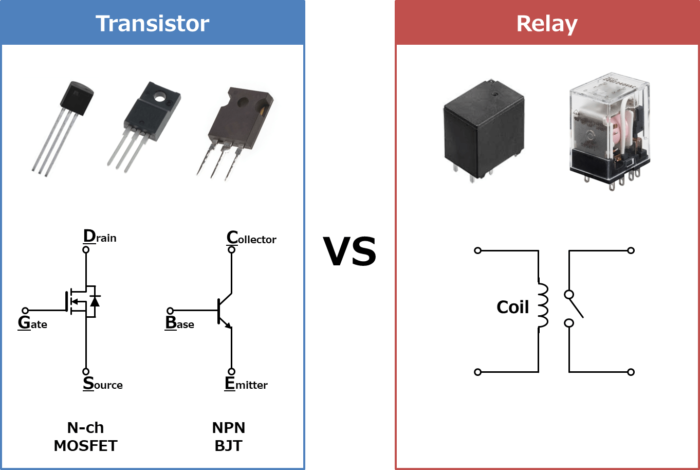Regarding the Transistor and Relay, this article will explain the information below.
- Difference Between Transistor and Relay
Difference Between Transistor and Relay

The figure above shows a transistor and a relay.
A transistor (MOSFET) performs switching operations by applying a voltage to its gate terminal (G). On the other hand, a relay performs switching operations by electromagnetic force generated by passing current through a coil.
Thus, transistor (MOSFET) and relay can be used as switches. So, what is the difference between a transistor (MOSFET) and a relay?
We will now explain the difference between a "transistor (MOSFET)" and a "relay".
A Bipolar Junction Transistor (also known as a BJT or BJT Transistor) performs switching operation by passing a current through its base terminal (B).
[Transistor vs Relay 01] Different insulation
![[Transistor vs Relay 01] Different insulation](https://electrical-information.com/wp-content/uploads/2022/07/Transistor-vs-Relay-01-Different-insulation-700x427.png)
In a transistor (MOSFET), the input (gate terminal side) and output (drain and source terminals) are not insulated.
In a relay, the input (coil side) and output (contact side) are insulated.
[Transistor vs Relay 02] Different size
Relays are larger in size than transistors.
[Transistor vs Relay 03] Different switching speed
Transistors use semiconductors for switching. Therefore, they can switch at high speeds in the MHz and GHz range.
Relays switch mechanically. Therefore, they cannot switch at high speeds; they cannot switch at speeds in the kHz range (the limit is around 200 Hz).
[Transistor vs Relay 04] Different current and voltage ratings
Transistors have a fixed rated current (the maximum current that can flow through the transistor) and rated voltage (the maximum voltage that can be applied to the transistor). Therefore, they can only be used within the range of the rated current and the rated voltage or less. They are also vulnerable to surge currents and surge voltages.
Relays have a higher rated voltage and rated current than transistors. Therefore, they are more resistant to surge currents and surge voltages. However, relay contacts may burn out if switching operation is performed at high currents.
[Transistor vs Relay 05] Different resistance value
ON-resistance
When turned on, a transistor has a minute resistance (this resistance is called on-resistance). Therefore, a voltage drop occurs when a current flows through the transistor.
Relays have a very small resistance when on (the resistance when on is called contact resistance). Therefore, compared to transistors, the voltage drop generated when current flows are small. Also, the power loss when a relay is on is smaller than that of a transistor. In addition, relays do not require heat dissipation measures when used within their ratings.
OFF-resistance
Transistors are not completely infinite resistance when off. Therefore, some leakage current will flow. This leakage current can affect electronic circuits.
Relays, when off, are physically isolated and therefore completely open and of infinite resistance.
[Transistor vs Relay 06] Different operating temperature
Transistors have a temperature range over which they can operate and may be damaged if that temperature range is exceeded.
Relays have a wider temperature range than transistors and are therefore more resistant to temperature than transistors.
[Transistor vs Relay 07] Different Lifespans
Transistors do not have a life span related to the number of switching operations.
Relays are mechanically operated, so the contacts wear out due to repeated switching operations. Therefore, when dealing with relays, it is necessary to consider the life expectancy due to contact wear.
Therefore, if switching operations need to be performed many times per second, it is more effective to use transistors.
[Transistor vs Relay 08] Relays can switch AC
![[Transistor vs Relay 08] Relays can switch AC](https://electrical-information.com/wp-content/uploads/2022/07/Transistor-vs-Relay-08-Relays-can-switch-AC-700x427.png)
Transistors can only switch DC.
Relays can switch both AC and DC.
[Transistor vs Relay 09] Different sounds when switching
Transistors are silent when switching.
Relays make a clicking sound when switching.
[Transistor vs Relay 10] Different Prices
Relays are more expensive than transistors.
[Transistor vs Relay 11] Transistors can amplify signals
Transistors can be used not only for switching applications but also for amplifying analog signals.
Relays, on the other hand, cannot amplify analog signals and can only be used for switching applications.
Summary
This article described the following information about "Transistor and Relay".
- Difference Between Transistor and Relay
Thank you for reading.